Now that’s more like it.
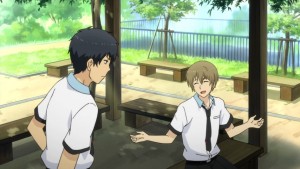 Needless to say, I think material like we saw with this episode is much more in the sweet spot for ReLIFE than most of the prior three episodes. High schoolers dealing with high school problems simply isn’t as interesting as adults dealing with adult problems – or with high school problems, for that matter. We’ve got no limit of the former in anime – in a broad range from bloody awful to quite splendid – but very few of the latter. The premise of ReLIFE is a fascinating one, but the show only runs on all cylinders when it’s actually exploiting it.
Needless to say, I think material like we saw with this episode is much more in the sweet spot for ReLIFE than most of the prior three episodes. High schoolers dealing with high school problems simply isn’t as interesting as adults dealing with adult problems – or with high school problems, for that matter. We’ve got no limit of the former in anime – in a broad range from bloody awful to quite splendid – but very few of the latter. The premise of ReLIFE is a fascinating one, but the show only runs on all cylinders when it’s actually exploiting it.
 I would say this episode was a stellar one, in fact – one of the best of the series. There are any number of reasons for that, but I think it starts with Kaizaki Arata himself. It’s easy to say “he’s changed a lot” over the course of the series, but I think what’s changed more is our perception of him. Driven I think by anime conditioning, most likely saw him as something of a loser when the series started – hell, Yoake certainly treated him like one. But the Kaizaki we know now was there all along – sure, maybe he was slumping a little bit, but while he’d lost his self-belief he’d never lost himself.
I would say this episode was a stellar one, in fact – one of the best of the series. There are any number of reasons for that, but I think it starts with Kaizaki Arata himself. It’s easy to say “he’s changed a lot” over the course of the series, but I think what’s changed more is our perception of him. Driven I think by anime conditioning, most likely saw him as something of a loser when the series started – hell, Yoake certainly treated him like one. But the Kaizaki we know now was there all along – sure, maybe he was slumping a little bit, but while he’d lost his self-belief he’d never lost himself.
 This whole business of visiting the grave of his sempai, Saiki Michiru, is obviously a very serious one, and Yoake treats it as such. It’s the one-year anniversary of her suicide, and Arata wants the blue pill to turn himself again so he can visit the grave without fear of running into puzzled former co-workers. But the scars haven’t healed – Arata still squirms at the idea of wearing a necktie, for starters. He most certainly still blames himself for what happened. And let’s be honest – that’s not entirely unjustified, though his intentions were above reproach. Yoake is worried enough that he agrees only on the condition that he go with – worried that Arata will try to “follow her”.
This whole business of visiting the grave of his sempai, Saiki Michiru, is obviously a very serious one, and Yoake treats it as such. It’s the one-year anniversary of her suicide, and Arata wants the blue pill to turn himself again so he can visit the grave without fear of running into puzzled former co-workers. But the scars haven’t healed – Arata still squirms at the idea of wearing a necktie, for starters. He most certainly still blames himself for what happened. And let’s be honest – that’s not entirely unjustified, though his intentions were above reproach. Yoake is worried enough that he agrees only on the condition that he go with – worried that Arata will try to “follow her”.
 Saiki is played by the stellar Itou Shizuka, and the flashbacks with her are powerful stuff. Kaizaki made a terrible mistake in the way he forced the issue against Saiki’s wishes, but this is the conundrum of places like this “black company”. Inaction is no answer – and as soon as we accept that injustice is inevitable and unavoidable, we’ve lost the war. I would argue that Arata has proved himself to be a truly admirable person – we see that in the way he takes it upon himself to try and help his classmates using the benefit of experience, despite his battle scars. We see it in the way he bristled at what was happening to Saiki, even if he erred in the way he responded. And it’s most assuredly confirmed during his visit to the drive.
Saiki is played by the stellar Itou Shizuka, and the flashbacks with her are powerful stuff. Kaizaki made a terrible mistake in the way he forced the issue against Saiki’s wishes, but this is the conundrum of places like this “black company”. Inaction is no answer – and as soon as we accept that injustice is inevitable and unavoidable, we’ve lost the war. I would argue that Arata has proved himself to be a truly admirable person – we see that in the way he takes it upon himself to try and help his classmates using the benefit of experience, despite his battle scars. We see it in the way he bristled at what was happening to Saiki, even if he erred in the way he responded. And it’s most assuredly confirmed during his visit to the drive.
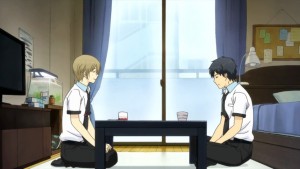 Make no mistake, these black companies are a real phenomenon in Japan (that’s the popular name for them in fact), and there have been multiple suicides attributed to them. They’re horrible places run by horrible people (one or two animation studios in Japan have had the reputation as being black companies), but what happens when Arata quits in the wake of Saiki’s suicide is by no means limited to them. Quitting a salaried corporate job simply isn’t done here – that the boss called Arata “gutless” is only the tip of the iceberg. One is effectively blacklisted, stigmatized for life if they quit this sort of job, especially as a young person.
Make no mistake, these black companies are a real phenomenon in Japan (that’s the popular name for them in fact), and there have been multiple suicides attributed to them. They’re horrible places run by horrible people (one or two animation studios in Japan have had the reputation as being black companies), but what happens when Arata quits in the wake of Saiki’s suicide is by no means limited to them. Quitting a salaried corporate job simply isn’t done here – that the boss called Arata “gutless” is only the tip of the iceberg. One is effectively blacklisted, stigmatized for life if they quit this sort of job, especially as a young person.
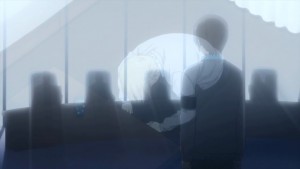 I love Japan, but I think I’ve been open in pointing out where I have serious issues with Japanese society, and we’re seeing some of these dark sides exposed in shows like ReLIFE and Battery this season. A lot of these come down to a common theme – blaming the victim. There’s an element of this deeply ingrained in the Japanese social contract, and we see it playing out in this episode. A victim of bullying – or the one who exposes the bullies – is seen as being selfish, because they bring shame on the group by shining a light on such behavior. Stoicism can be a wonderful quality and the Japanese have it in spades, and we saw the best side of it come through in the response to the Tohoku earthquake and tsunami. But too much stoicism can be a real problem, too (just look at the unbelievable levels of apathy when it comes to Japanese politics and government) and we sure see that here.
I love Japan, but I think I’ve been open in pointing out where I have serious issues with Japanese society, and we’re seeing some of these dark sides exposed in shows like ReLIFE and Battery this season. A lot of these come down to a common theme – blaming the victim. There’s an element of this deeply ingrained in the Japanese social contract, and we see it playing out in this episode. A victim of bullying – or the one who exposes the bullies – is seen as being selfish, because they bring shame on the group by shining a light on such behavior. Stoicism can be a wonderful quality and the Japanese have it in spades, and we saw the best side of it come through in the response to the Tohoku earthquake and tsunami. But too much stoicism can be a real problem, too (just look at the unbelievable levels of apathy when it comes to Japanese politics and government) and we sure see that here.
 Even if it was staged by Yoake – and even if Arata knew that – I deeply admire the way he spoke to those kouhai who visited Saiki’s grave. He didn’t gloss over how hard his life had been, he didn’t sugarcoat the bitter road ahead for anyone who decides to follow the path he chose. But he didn’t back down from the truth – the company he worked for was toxic, and even a life with hardships was better than a life that was nothing more than a living death. Much of what Arata teaches his younger colleagues in ReLIFE boils down simply to having courage and trusting your personal beliefs. Doing so has placed him on a hard road, but he’s remained true to himself, and that he can finally admit aloud that he’s glad he quit his job is certainly a milestone in trying to move forward.
Even if it was staged by Yoake – and even if Arata knew that – I deeply admire the way he spoke to those kouhai who visited Saiki’s grave. He didn’t gloss over how hard his life had been, he didn’t sugarcoat the bitter road ahead for anyone who decides to follow the path he chose. But he didn’t back down from the truth – the company he worked for was toxic, and even a life with hardships was better than a life that was nothing more than a living death. Much of what Arata teaches his younger colleagues in ReLIFE boils down simply to having courage and trusting your personal beliefs. Doing so has placed him on a hard road, but he’s remained true to himself, and that he can finally admit aloud that he’s glad he quit his job is certainly a milestone in trying to move forward.


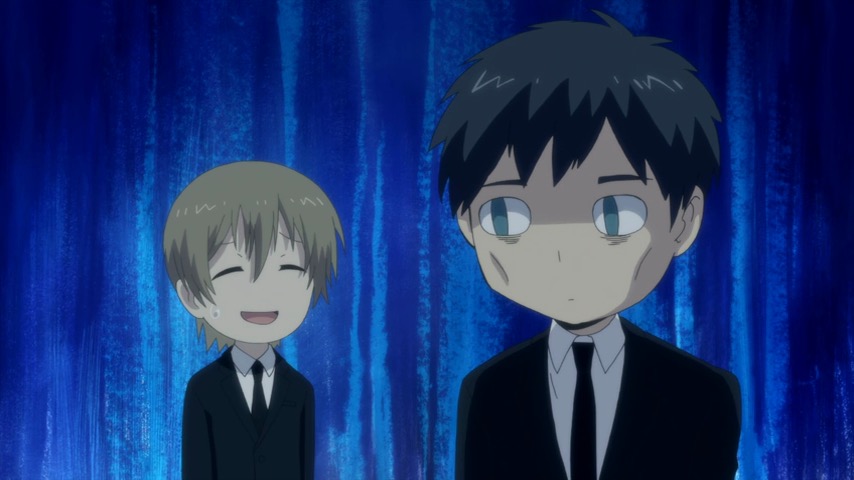


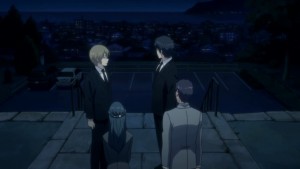
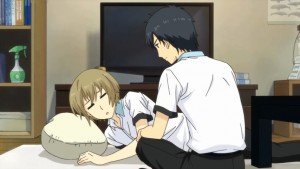
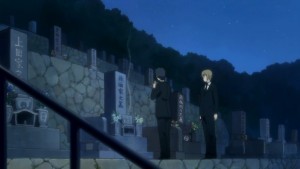

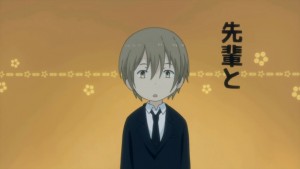
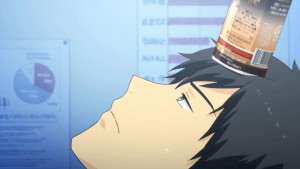
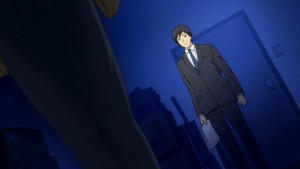
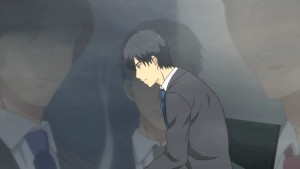

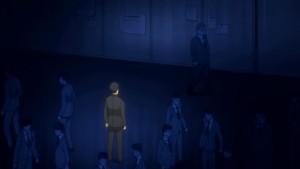
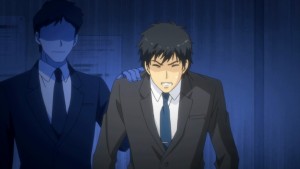
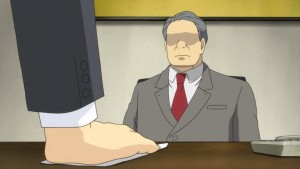
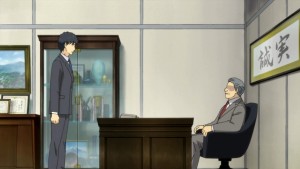
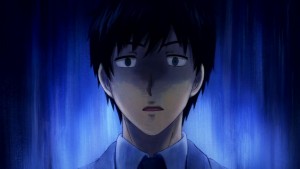

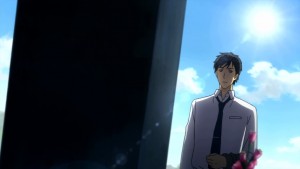
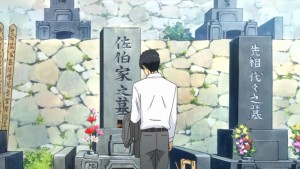
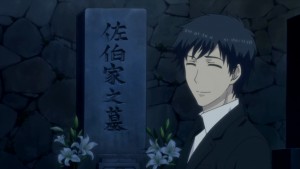
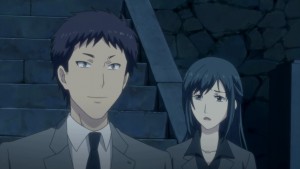
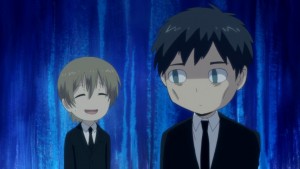



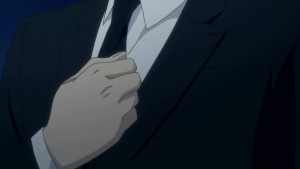
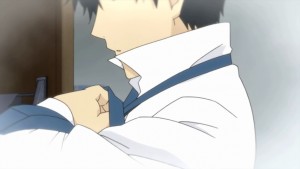


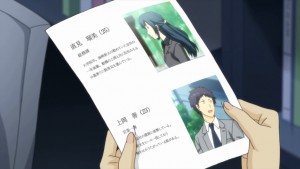
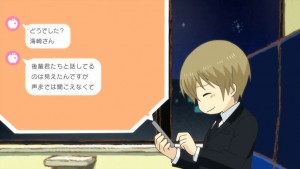
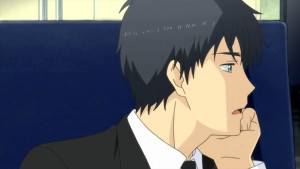



sarasva
August 24, 2016 at 11:05 pmI thought ReLIFE was just another anime about romanticizing high school drama through adult lens. That is, until your reviews got me into watching it.
For me, the most disturbing thing other than the suicide was how Arata, essentially a kind man with strong and good ideals, quickly lost his courage and confidence after quitting his job. He got so deep into doubting himself and his decision to quit. We thought Arata was a loser at the beginning of the anime – maybe Arata thought so too. And even now he probably doesn’t think he’s doing great either – but he is moving forward. It just makes me sad to see how easy it is for one to lose one’s confidence even after making the right decision (to quit, to confront the bullying, etc.).
In other news, the ReLIFE company is proving again to employ some creep-level procedures of stalking and monitoring its subjects. Yoake’s job sounds like a lot of work – no wonder he has a hard time getting up.